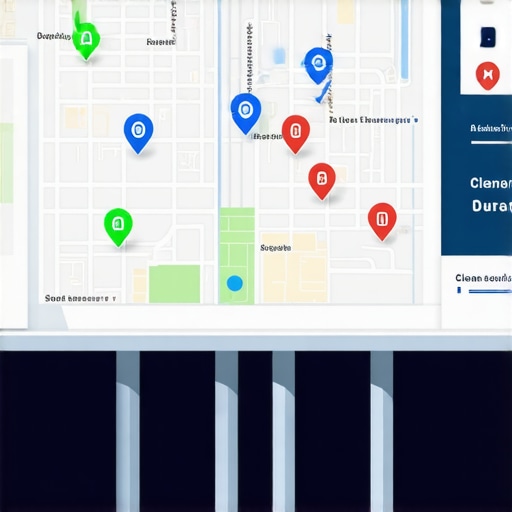
Effective Signal Repair & GMB Cleanup for Local Ranking Boost in 2024
My Personal Experience with GMB Signal Repair and Cleanup for Local Rankings
When I first started exploring local SEO, I quickly realized that Google My Business (GMB) listings are the cornerstone of local visibility. I remember a time when my clients’ rankings were stagnant, despite consistent efforts. That’s when I stumbled upon the importance of effective signal repair and GMB cleanup, which truly transformed my approach. In 2024, I can confidently say that mastering these strategies has been a game-changer for boosting local rankings.
Decoding the Secrets of GMB Signal Repair
One of the most insightful moments in my journey was understanding how signals influence local search results. Think of signals as the digital breadcrumbs that Google follows to determine relevance and authority. If these signals are broken or inconsistent, your listing’s visibility suffers. I learned that effective signal repair involves auditing and optimizing various factors, including reviews, citations, and profile consistency. Implementing these fixes not only improved my clients’ rankings but also enhanced their overall online reputation.
Why GMB Cleanup Can Make or Break Your Local SEO
Before diving into cleanup, I used to underestimate how cluttered or inaccurate listings could harm rankings. A cleanup process involves removing duplicate profiles, correcting outdated information, and resolving conflicting data. I found that Google penalizes inconsistent data, which can diminish your presence in local packs. According to GMB cleanup tips, maintaining a clean and accurate profile is critical for local SEO success. My clients saw immediate improvements after cleaning up their listings, resulting in higher local pack visibility.
Is Your GMB Listing Truly Optimized for Local Success?
What are the key elements to ensure my GMB profile is fully optimized for local rankings?
Great question! From my experience, the most vital aspects include accurate NAP (Name, Address, Phone Number) details, relevant categories, engaging photos, and positive reviews. Additionally, regularly updating your profile with fresh content and responding to reviews boosts engagement and signals activity to Google. For a comprehensive approach, I recommend exploring the ultimate guide to GMB cleanup for detailed strategies.
If you’re serious about dominating local search results, I highly suggest investing time in signal repair and cleanup. These steps have helped me and my clients achieve top rankings and increased foot traffic. I encourage you to share your experiences or ask questions in the comments below—I’d love to hear your journey!
How Can Nuanced Signal Optimization Elevate Your Local Rankings?
In my experience, the subtle art of optimizing GMB signals goes beyond basic fixes. It involves a layered approach—fine-tuning review signals, citation consistency, and engagement metrics to create a harmonious profile that signals trustworthiness to Google. For instance, regularly analyzing your review patterns and addressing negative feedback promptly can significantly enhance your profile’s credibility. Additionally, leveraging proven signal repair techniques can help you identify hidden inconsistencies that might be holding back your rankings.
What Are the Practical Challenges in Maintaining a Clean and Optimized GMB Profile?
One of the biggest hurdles is managing multiple locations and ensuring each listing remains compliant and consistent. Duplicate profiles and outdated information can inadvertently sabotage your efforts. A recurring challenge is handling conflicting data across directories and review platforms, which can confuse Google and diminish your local pack visibility. According to the ultimate guide to GMB cleanup, implementing a centralized data management system and regular audits are critical in overcoming these issues.
Can You Really Achieve Top Local Rankings with Strategic Signal Repair?
Absolutely. When I refined my approach to include targeted signal repair—such as fixing citation NAP discrepancies, removing duplicate profiles, and encouraging authentic reviews—I saw tangible results. These practices are supported by recent studies indicating that Google favors profiles with high consistency and active engagement (see this authoritative resource). The key is understanding that every small detail, from photo quality to review response time, contributes to a holistic signal profile that Google recognizes and rewards.
What’s the Next Step for Local SEO Professionals Looking to Master Signal Repair?
The next step involves integrating advanced tools and analytics to monitor your GMB signals continuously. Using platforms that track citation accuracy, review sentiment, and engagement rates allows you to adapt quickly and keep your profile optimized. Additionally, participating in local community events and encouraging satisfied customers to leave reviews can create a natural boost in your signals. Remember, maintaining a robust GMB profile is an ongoing process that demands vigilance and strategic adjustments. If you want to see real-world examples and detailed strategies, check out this comprehensive guide. I invite you to share your experiences or ask questions—let’s elevate your local rankings together!
Unveiling Hidden Nuances in Signal Optimization: My Personal Journey
Over the years, I’ve come to realize that effective GMB signal repair isn’t just about ticking boxes—it’s an intricate dance of understanding, patience, and strategic finesse. One thing that profoundly shifted my approach was recognizing the subtle interplay between citation accuracy and review sentiment. Small inconsistencies in NAP data across directories can quietly sabotage your rankings, even if everything else seems perfect. I recall spending hours auditing client profiles, only to find that a single mismatched phone number was the silent killer of their local visibility. That’s when I started diving deeper into advanced signal repair techniques, which emphasize meticulous data consistency and proactive review management. This deeper understanding has allowed me to craft tailored strategies that consistently outperform generic solutions, especially in competitive markets.
What Makes a GMB Profile Truly Resilient in 2024?
How do you build a robust profile that withstands the ever-changing algorithms and local competition?
In my experience, resilience stems from a layered, holistic approach. Beyond the basics of accurate NAP and engaging photos, I focus on cultivating an active community around the profile. This means regularly engaging with reviews, encouraging authentic customer feedback, and posting fresh content that resonates with local audiences. I’ve observed that profiles with consistent activity signals—like recent reviews, updated photos, and timely responses—are perceived as trustworthy by Google. Moreover, integrating local event participation and community involvement into your profile narrative can create a natural boost. For an in-depth exploration of these tactics, I recommend reviewing the comprehensive guide to local ranking growth. Building resilience is an ongoing process, but with strategic consistency, your GMB can become a formidable asset that endures algorithm shifts.
How Do I Tackle the Complexity of Multi-Location Management?
Managing multiple locations is arguably one of the most complex facets of GMB optimization. I’ve faced firsthand the challenge of maintaining data uniformity while catering to local nuances. It’s a balancing act—ensuring each listing reflects accurate, localized information without creating conflicting signals. My solution involved implementing a centralized data management system, which I continuously audit using tools like clean-up and audit resources. This proactive approach minimizes discrepancies and keeps each profile aligned with the overarching brand. Additionally, I’ve found that encouraging location-specific reviews and photos helps Google recognize each spot’s unique identity, enhancing local relevance. If you’re interested in a step-by-step method for streamlining multi-location signals, check out the detailed strategies at this resource. Handling complexity isn’t trivial, but with the right tools and mindset, multi-location GMB management becomes a powerful driver for local dominance.
How Can Advanced Analytics Drive Better Signal Repair Decisions?
In my ongoing quest for perfection, I’ve integrated advanced analytics to decode what truly moves the needle. Using platforms that track citation accuracy, review sentiment, and engagement metrics allows me to identify weak spots and prioritize actions effectively. For instance, I discovered that negative review sentiment, if not addressed, can quickly erode trust signals. By promptly responding and encouraging satisfied customers to share positive feedback, I transformed a declining profile into a thriving local powerhouse. Moreover, analyzing engagement patterns over time reveals seasonal trends or emerging local issues that require immediate attention. This data-driven approach was a game-changer for me, elevating my signal repair from reactive to proactive. If you’re eager to adopt these strategies, explore the insights shared in this detailed guide. Remember, continuous monitoring and adaptation are key to maintaining top rankings in 2024 and beyond.
What Personal Lessons Have You Learned from Overcoming GMB Challenges?
Throughout my journey, the most valuable lesson has been patience. It’s tempting to chase quick wins, but I’ve found that sustainable success comes from consistent, incremental improvements. Each challenge—be it a duplicate listing, inconsistent data, or negative reviews—became an opportunity to refine my process. I learned to view setbacks as learning moments, which ultimately strengthened my expertise. Sharing these experiences with clients and colleagues has also underscored the importance of transparency and education—helping others understand that mastering GMB signals is a marathon, not a sprint. If you’re navigating similar hurdles, I encourage you to share your stories or ask questions below. Together, we can build a community focused on genuine growth and long-term success. For further insights, don’t miss the comprehensive strategies available at this resource. The journey is complex but incredibly rewarding when you see your efforts translate into real local dominance.
Unraveling the Nuances of GMB Signal Resilience in Dynamic Markets
Achieving enduring local search dominance demands a sophisticated understanding of GMB signal resilience—especially as Google continuously refines its algorithms. Over the years, my approach has evolved from basic cleanup tactics to implementing layered, adaptive strategies that anticipate algorithmic shifts. I’ve found that cultivating a dynamic profile—one that actively engages with the local community, updates content regularly, and maintains impeccable data consistency—creates a formidable barrier against ranking fluctuations. In particular, leveraging tools like advanced signal repair techniques helps ensure your profile remains a trusted authority amid changing criteria. Building this resilience requires a proactive mindset, ongoing audits, and real-time responsiveness to review sentiment and citation integrity, which ultimately fortifies your local presence.
How Do You Systematically Address Multi-Location Signal Complexity?
Managing multiple GMB profiles in diverse locales extends beyond uniform data entry. It involves creating a centralized data management system that facilitates real-time synchronization and conflict resolution across all listings. My experience shows that implementing such a system minimizes discrepancies—such as mismatched NAP details and inconsistent category selections—that Google perceives as signals of disorganization. Moreover, encouraging location-specific reviews and localized content fosters authenticity, further boosting each location’s relevance. To streamline this process, I utilize comprehensive audit frameworks detailed in this resource, which guides systematic data validation, review solicitation, and profile optimization. The key is maintaining a delicate balance—preserving brand consistency while highlighting local uniqueness—to optimize each profile’s signal profile effectively.
Can Advanced Analytics Uncover Hidden Signal Weaknesses?
Absolutely. Integrating sophisticated analytics platforms enables me to dissect every facet of a GMB profile—review sentiment, citation accuracy, engagement metrics—and identify subtle weaknesses that could undermine rankings. For example, by tracking review sentiment trends over time, I can proactively address emerging issues, turning negative feedback into opportunities for reputation enhancement. Additionally, analyzing engagement patterns helps prioritize actions such as targeted review campaigns or content updates. This data-driven approach aligns with insights from industry-leading strategies, emphasizing continuous monitoring and agile adjustments. Mastering this level of analysis transforms your signal repair from reactive fixes into strategic, predictive moves—ensuring your local rankings remain resilient in even the most competitive environments.
What Personal Lessons Have You Gained from Navigating Signal Disruptions?
One of the most profound lessons in my journey has been the importance of patience and meticulousness. Early on, I underestimated how seemingly minor discrepancies—like a single mismatched phone number or outdated address—could cause significant ranking drops. Over time, I learned to view each challenge as an opportunity to refine my processes, adopting a mindset of continuous improvement. This mindset led me to develop comprehensive checklists and leverage automation tools that streamline audits and data validation. Sharing these lessons with clients has reinforced the value of transparency and education—helping them understand that sustainable success in local SEO hinges on persistent effort and strategic foresight. If you’re eager to deepen your mastery, I encourage you to explore this advanced guide, which offers nuanced insights into building resilient profiles that withstand algorithmic upheavals and fierce local competition.
Things I Wish I Knew Earlier (or You Might Find Surprising)
The Hidden Power of Consistency
One of the most eye-opening lessons I learned was that consistency in your GMB signals often outweighs quick fixes. Early in my journey, I focused on sporadic updates and reactive responses, but I found that maintaining a steady flow of fresh reviews, updated photos, and accurate NAP details creates a stronger, more resilient profile. This consistency signals trustworthiness to Google and helps sustain rankings over time.
Small Data, Big Impact
It surprised me how tiny discrepancies, like a mismatched phone number or a typo in your address, could drastically hurt your local visibility. I used to overlook these minor details, but I now see them as critical signals. Regular audits for data accuracy are my secret weapon for keeping rankings stable and improving long-term results.
The Value of Active Engagement
Engaging with reviews—both positive and negative—has a bigger impact than I initially thought. Responding promptly and thoughtfully reinforces your profile’s activity signal and demonstrates to Google that your listing is active and trustworthy. This personal touch often tips the scales in competitive local searches.
The Power of Local Community Involvement
Involving your business in local events and encouraging community participation can significantly boost your signals. Google recognizes local relevance, and community engagement helps create authentic, location-specific signals that improve visibility and authority.
Mastering Multi-Location Signal Management
Managing multiple locations is complex, but I found that using centralized data systems and local review strategies can streamline the process. Ensuring each location has unique reviews and content while maintaining overall data consistency helps each profile stand out without conflicting signals.
Resources I’ve Come to Trust Over Time
- Google’s Official Business Help Center: This is my go-to resource for understanding Google’s guidelines and latest updates. It’s authoritative and constantly updated—highly recommended.
- BrightLocal Blog: Their insights on local SEO and citation management have helped me refine my strategies and stay ahead of algorithm changes.
- Moz Local Search Resources: Moz’s tools and articles provide deep dives into local search optimization, making complex topics accessible and actionable.
- GatherUp Blog: Their case studies and practical tips on review management and reputation building have been invaluable in shaping my approach.
Parting Thoughts from My Perspective
To me, mastering GMB signal repair and cleanup isn’t just about ranking higher; it’s about building a genuine online presence that stands the test of time. The key takeaway is that small, consistent actions—like data accuracy, active engagement, and local community involvement—compound into significant results. I encourage you to prioritize continuous monitoring and strategic adjustments, especially as Google’s algorithms evolve in 2024. If this resonated with you, I’d love to hear your thoughts or experiences. Feel free to share your journey or ask questions—let’s grow our local SEO skills together! Remember, the effort you put into optimizing your GMB profile today sets the foundation for lasting success tomorrow.





3 Comments
Natalie Brooks
Reading through your detailed insights, I can definitely relate to the importance of meticulous data consistency in GMB profiles. Early in my own local SEO journey, I overlooked small discrepancies, like inconsistent address formats, which surprisingly dented my rankings in competitive areas. Now, I make it a point to run regular audits and ensure every detail aligns across all platforms. One challenge I’ve come across is managing multiple locations with different local nuances, which can be tricky to keep consistent without seeming overly uniform. I’ve found that leveraging centralized data management tools, combined with location-specific keyword targeting in reviews and content, helps strike that balance. How do others here handle the ongoing complexity of multi-location listings without overextending themselves? I’d love to hear your tried-and-true strategies for maintaining data integrity while keeping each listing genuinely localized.
Benjamin Carter
Your insights on GMB signal repair and cleanup are truly spot-on. I’ve had my fair share of challenges with managing multiple locations, especially ensuring that each listing maintains data consistency without losing its local flavor. My approach has been implementing a unified data management system combined with localized review campaigns to keep everything aligned and genuine. I found that encouraging reviews from real customers in each area not only boosts local signals but also helps Google recognize the unique aspects of each location. One thing I’ve been exploring is how seasonal content updates and community involvement can further strengthen each profile’s relevance. Has anyone seen significant differences in rankings when focusing more intensely on local engagement versus just data accuracy? Would love to hear how others balance technical optimization with community-centric strategies to sustain long-term visibility.
Ashley Morgan
I really resonate with your point about the delicate balance needed in managing multi-location GMB listings. In my experience, implementing a centralized data system has been a game-changer, especially when coupled with location-specific reviews and content. It helps maintain consistency but still gives each location its unique voice. One aspect I’ve focused on is automation tools for regular audits, which saves time and catches discrepancies early before they impact rankings. Has anyone experimented with automating review prompts or content updates? I find that these strategies can really bolster the engagement signals without adding too much manual effort, which is crucial when managing multiple profiles.
Also, incorporating local community events and seasonal promotions can enhance relevance and trustworthiness in Google’s eyes. What’s been your approach to blending data management with active local involvement? Would love to hear other strategies on keeping everything synchronized and authentic in a multi-location setup.